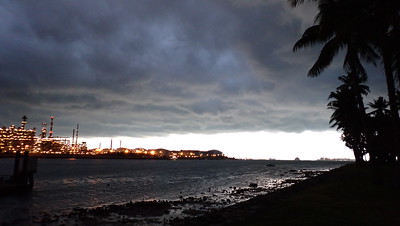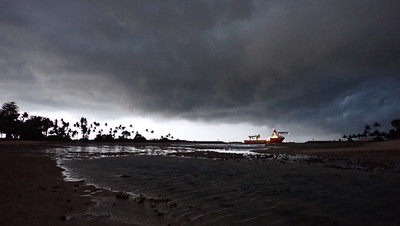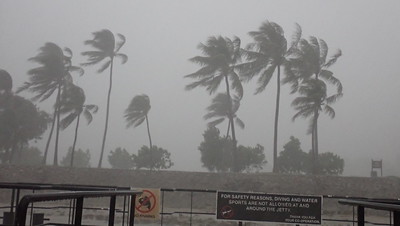Although Pulau Hantu lies just across the petrochemical plants on Pulau Bukom, there are living reefs and even mangroves here. Despite being hit by a storm in the middle of our survey, I saw healthy corals, mangroves although the seagrass situation is still sad.
Thankfully, the team spread out and managed to cover lots of ground in the short time before the storm hit. Kok Sheng reached the reef edge before the weather hit and it seems the corals there are still doing well. He, together with Jianlin, Richard and Tammy also spotted colourful and interesting marine life. Check out their albums linked at the end of the post.
I saw the usual colourful reef life: Fire anemone, Giant carpet anemone (no anemonefish), colourful crabs, a Red feather star and the common White-rumped sea cucumber. There were also Common sea stars on the high shore.I saw the usual common hard and also Mushroom corals, Brain corals. Also some small Leathery soft corals and Asparagus flowery soft coral. The patch of Branching montipora coral at the mouth of the northern lagoon that I first notice in May 22 is still there. I also noticed a patch in the middle of the lagoon. And there some smaller clumps outside the seawall too.It appears, a large field has also started to settle in the lagoon between Hantu Kecil and Hantu Besar.
 |
| Photo by Tommy Arden |
The mangroves growing on the western seawall of the northern lagoon are still doing well. There are tall mature trees growing on the seawall (with some rare species), some medium to tall ones on the shore. Most of the trees were flowering or producing propagules. It's so nice to see mangroves next to corals in this lagoon.The big Perepat tree in the northern lagoon, however, appears to have been hit by lightning? Half of the tree is dead. I didn't see much Tape seagrass, most were cropped short or only a few blades. Even Spoon seagrass was scarce.Thanks to weather radar updates at 10min intervals, we knew we were in for heavy weather when we first arrived. We estimated we had about 30mins as lighting played in the distance.
All too soon, we could feel the wind start to pick up and that sharp 'ozone' smell that warns of dangerous weather even in the dark. We walked quickly back to shelter as the storm rolled in overhead, obliterating the sunrise.
We reached shelter in time as the rain and high winds exploded around us. Although Sumatras are fierce, they are generally brief. We managed to resume the survey briefly before the tide finally turned. We were also hit by rain on our last two surveys at Pulau Hantu: May 22 and Mar 21.
We reached shelter in time as the rain and high winds exploded around us. Although Sumatras are fierce, they are generally brief. We managed to resume the survey briefly before the tide finally turned. We were also hit by rain on our last two surveys at Pulau Hantu: May 22 and Mar 21.
As we left, dive boats started to arrive. Pulau Hantu is a favourite local dive spot. One of our team members Chay Hoon was diving today! We also saw a small boat laying nets at the reef, and we have started to see fish traps again on the shore.
What is the fate of Pulau Hantu?
Pulau Hantu and all the terumbus west of it are slated for massive reclamation outlined recently in the Long-Term Plan Review. Singapore's submerged reefs are often out of sight under the high tide and thus forgotten.
The Singapore Blue Plan 2018
Pulau Semakau and nearby islands and submerged reefs have been recommended by the Singapore Blue Plan 2018 for Immediate Conservation Priority. The Blue Plan recommends the intertidal and subtidal marine areas of Pulau Semakau and adjacent Pulau Hantu, and Pulau Jong to be designated Marine Reserve.
The Blue Plan highlights that Pulau Semakau and its associated patch reefs comprise many ecosystems: coral reefs, mangrove areas, intertidal sandflats, seagrass meadows, and coral reefs. The subtidal area of Pulau Jong is larger than the terrestrial area. Pulau Hantu is a popular dive site has seen increasing interest in the past decade due to biodiversity awareness. If protection is accorded to these three islands, zonation plans for use can be implemented to manage tourism and human impacts.
DOWNLOAD the Plan, SUPPORT the Plan! More on the Singapore Blue Plan 2018 site.
What is the fate of Pulau Hantu?
Pulau Hantu and all the terumbus west of it are slated for massive reclamation outlined recently in the Long-Term Plan Review. Singapore's submerged reefs are often out of sight under the high tide and thus forgotten.
The Singapore Blue Plan 2018
Pulau Semakau and nearby islands and submerged reefs have been recommended by the Singapore Blue Plan 2018 for Immediate Conservation Priority. The Blue Plan recommends the intertidal and subtidal marine areas of Pulau Semakau and adjacent Pulau Hantu, and Pulau Jong to be designated Marine Reserve.
The Blue Plan highlights that Pulau Semakau and its associated patch reefs comprise many ecosystems: coral reefs, mangrove areas, intertidal sandflats, seagrass meadows, and coral reefs. The subtidal area of Pulau Jong is larger than the terrestrial area. Pulau Hantu is a popular dive site has seen increasing interest in the past decade due to biodiversity awareness. If protection is accorded to these three islands, zonation plans for use can be implemented to manage tourism and human impacts.
DOWNLOAD the Plan, SUPPORT the Plan! More on the Singapore Blue Plan 2018 site.
Photos by others on this survey
Loh Kok Sheng
Richard Kuah
Tammy Lim
Jianlin Liu
Tommy Arden













